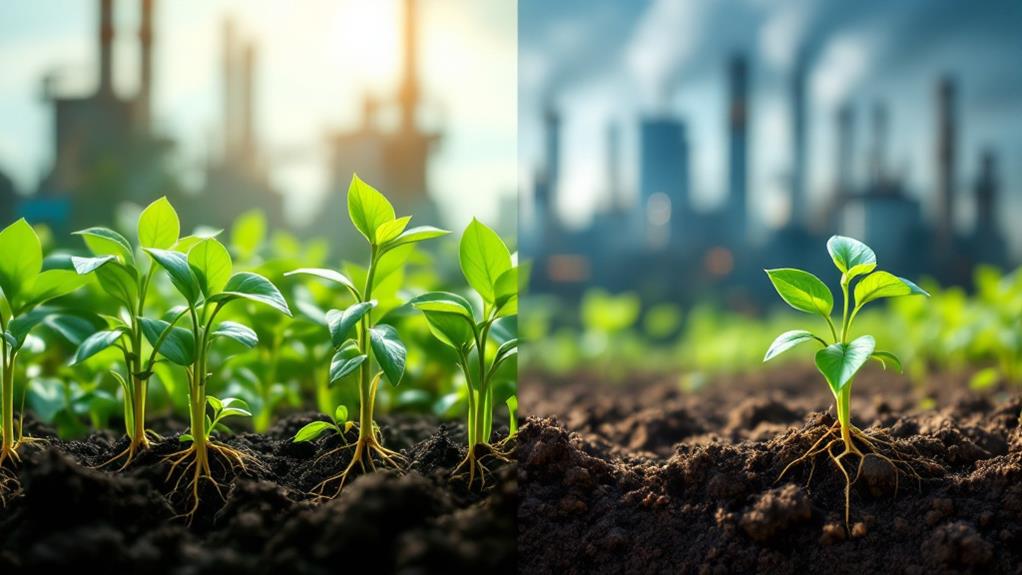Phytoremediation techniques use plants to clean up contaminated soil and water. You’ll find several methods, including phytoextraction, which removes pollutants through plant uptake, and rhizofiltration, which uses roots to filter water. Phytostabilization immobilizes contaminants in soil, while phytovolatilization releases them as gases. Phytodegradation and rhizodegradation break down organic pollutants using plant enzymes and rhizosphere microbes. You can also use hydraulic control to manage contaminated groundwater with deep-rooted trees. These eco-friendly approaches offer cost-effective alternatives to traditional remediation methods, with applications in both rural and urban environments. Exploring each technique will reveal their unique strengths and potential applications.
Plant Selection for Phytoremediation
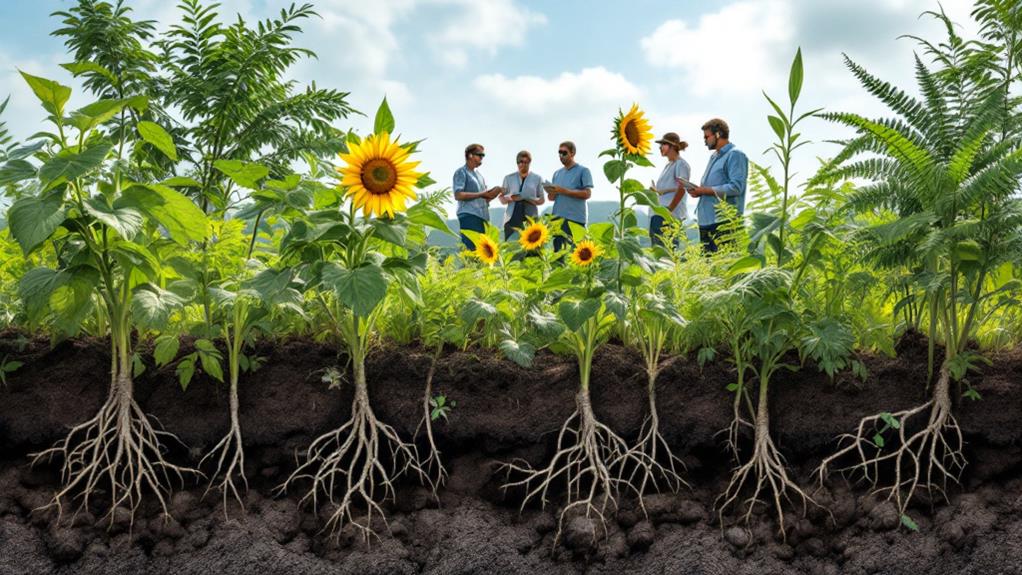
When it comes to plant selection for phytoremediation, choosing the right species can make or break your project. You’ll need to take into account several factors to guarantee success in removing contaminants from soil, water, or air.
First, assess the type of pollutants you’re dealing with. Some plants excel at absorbing heavy metals, while others are better suited for organic compounds. For instance, sunflowers and Indian mustard are known for their ability to accumulate metals like lead and uranium, while poplar trees are effective at removing organic solvents.
Next, evaluate the climate and soil conditions of your site. Select plants that can thrive in the local environment, as they’ll be more likely to grow vigorously and extract contaminants effectively. Native species often have an advantage here, as they’re already adapted to local conditions.
Take into account the plant’s growth rate and biomass production. Fast-growing species with high biomass can generally remove more contaminants in a shorter time frame. However, you’ll also need to factor in the ease of harvesting and disposing of contaminated plant material.
Root depth is another significant aspect. Deep-rooted plants can access contaminants further down in the soil profile, while shallow-rooted species may be more suitable for surface-level pollution.
Don’t forget to examine the plant’s tolerance to the target pollutants. Some species can withstand high concentrations of contaminants, while others may struggle or die off.
Lastly, think about using a combination of plants to maximize effectiveness. A diverse selection can target multiple pollutants and create a more resilient phytoremediation system.
Phytoextraction: Uptake and Harvesting
How does phytoextraction work in practice? You’ll find that this technique involves using plants to absorb contaminants from soil or water through their roots and accumulate them in their above-ground tissues. The process begins with selecting hyperaccumulator plants, which can concentrate pollutants at levels 100 times higher than normal plants without suffering phytotoxic effects.
Once you’ve chosen suitable plants, you’ll need to prepare the contaminated site. This may involve adding chelating agents to increase the bioavailability of metals or adjusting soil pH to optimize uptake. You’ll then plant your chosen species and allow them to grow, absorbing contaminants as they develop.
Throughout the growing season, you’ll need to monitor the plants’ health and contaminant uptake rates. You may need to apply fertilizers or adjust irrigation to maximize growth and pollutant accumulation. When the plants have reached their maximum contaminant concentration, typically at the end of the growing season, it’s time to harvest.
You’ll cut the plants close to the ground, taking care not to spread contaminated plant material. The harvested biomass must be properly disposed of or processed to recover valuable metals. You may need to repeat this cycle several times to achieve the desired level of soil remediation.
After harvesting, you can either replant the site with new phytoextraction crops or switch to other remediation techniques if contaminant levels have decreased sufficiently. Remember, phytoextraction is a long-term process that can take several growing seasons to achieve significant results.
Rhizofiltration: Root-Based Water Purification
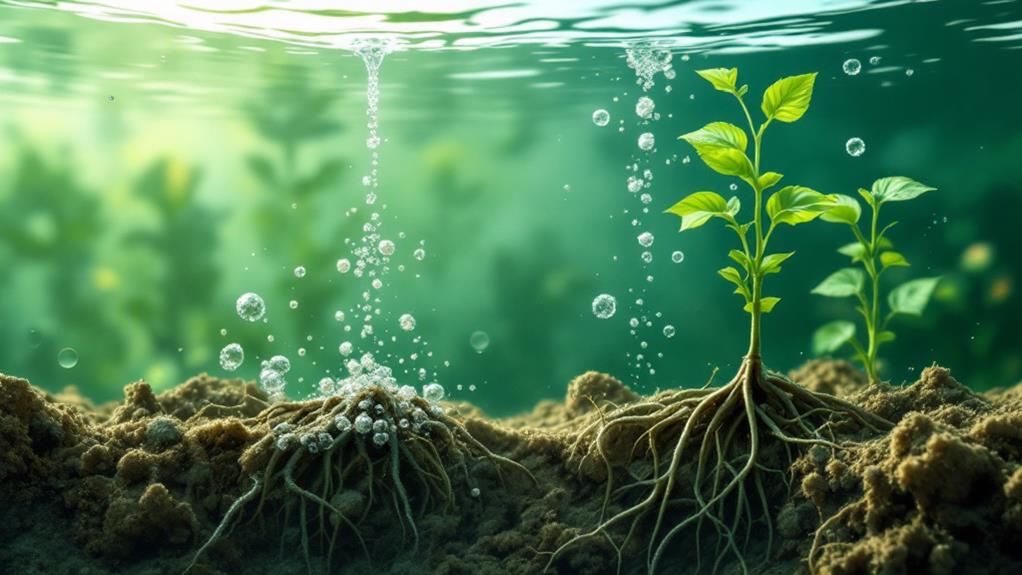
While phytoextraction focuses on soil remediation, rhizofiltration applies similar principles to water purification. This technique utilizes plant roots to absorb, concentrate, and precipitate contaminants from polluted water. You’ll find rhizofiltration particularly effective for removing heavy metals, radionuclides, and certain organic compounds from aqueous solutions.
To implement rhizofiltration, you’ll typically use terrestrial plants rather than aquatic ones. You’ll grow these plants hydroponically, allowing their roots to develop in nutrient-rich water. Once the root system is well-established, you’ll introduce the contaminated water. The plants’ roots will then absorb and accumulate the pollutants.
You’ll notice that different plant species have varying affinities for specific contaminants. For instance, sunflowers excel at removing uranium, while Indian mustard is effective for lead and chromium. You’ll need to select the appropriate plant species based on the target pollutants and local environmental conditions.
As the plants absorb contaminants, you’ll periodically harvest them to remove the accumulated pollutants from the system. You can then process the harvested plant material to recover valuable metals or dispose of it safely.
Rhizofiltration offers several advantages over conventional water treatment methods. It’s cost-effective, environmentally friendly, and can treat large volumes of water with low contaminant concentrations. You’ll find it particularly useful for treating industrial effluents, agricultural runoff, and contaminated groundwater.
However, you should be aware of its limitations. Rhizofiltration is generally slower than chemical treatments and may not be suitable for highly toxic or concentrated pollutants. You’ll also need to take into account factors like pH, temperature, and the presence of competing ions, which can affect the process’s efficiency.
Phytostabilization: Immobilizing Soil Contaminants
In contrast to phytoextraction and rhizofiltration, phytostabilization doesn’t remove contaminants from soil. Instead, it focuses on immobilizing pollutants within the soil matrix, reducing their bioavailability and preventing their spread to other areas or ecosystems.
You’ll find that phytostabilization relies on plants with extensive root systems and specific chemical properties. These plants stabilize contaminants through various mechanisms, including absorption, adsorption, and precipitation. By binding pollutants to their roots or within the rhizosphere, they effectively create a barrier that limits the contaminants’ mobility.
When you’re considering phytostabilization, you’ll want to select plants that are tolerant to high levels of contaminants and can thrive in the targeted soil conditions. Species like certain grasses, legumes, and trees are often used due to their robust root systems and adaptability.
You’ll notice that this technique is particularly useful for large areas contaminated with heavy metals or organic pollutants. It’s an effective method for managing tailings from mining operations, contaminated industrial sites, and areas affected by agricultural runoff.
One of the key advantages you’ll find with phytostabilization is its cost-effectiveness and minimal environmental disruption. You won’t need to excavate or transport contaminated soil, which can be expensive and potentially risky. Additionally, the plants used in this process can help prevent soil erosion and improve overall soil quality.
However, you should be aware that phytostabilization isn’t a permanent solution. It requires ongoing maintenance and monitoring to guarantee the continued immobilization of contaminants. You’ll need to regularly assess the plants’ health and the soil’s stability to maintain the effectiveness of this remediation technique.
Phytovolatilization: Releasing Pollutants as Gases
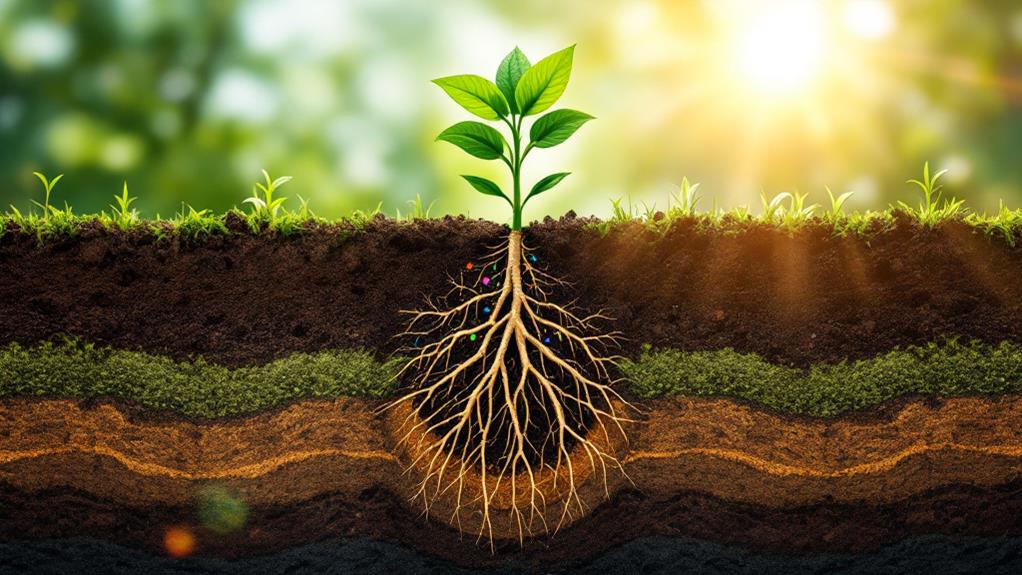
Turning our attention to phytovolatilization, we encounter a unique phytoremediation technique that transforms pollutants into gaseous form. This process involves plants absorbing contaminants from the soil or water, converting them into less toxic or non-toxic compounds, and releasing them into the atmosphere through transpiration.
You’ll find that phytovolatilization is particularly effective for removing certain organic pollutants and heavy metals, such as mercury and selenium. Plants like poplar trees, Indian mustard, and some species of Brassica are known for their ability to perform this task efficiently.
When you implement phytovolatilization, you’re fundamentally using plants as natural pumps and filters. They draw up contaminated groundwater through their roots, metabolize the pollutants, and release them as harmless gases through their leaves. This method’s main advantage is that it completely removes contaminants from the site, unlike other techniques that may simply immobilize them.
However, you should be aware of potential drawbacks. The released gases might pose risks if they’re toxic or contribute to air pollution. Additionally, the process can be slow and may not be suitable for all types of contaminants or environmental conditions.
To maximize phytovolatilization’s effectiveness, you’ll need to carefully select plant species based on their ability to uptake and transform specific pollutants. You’ll also want to weigh factors like climate, soil type, and contaminant concentration. By optimizing these variables, you can harness the power of plants to clean up polluted sites through this innovative phytoremediation technique.
Phytodegradation: Breaking Down Organic Compounds
Phytodegradation stands out as a powerful phytoremediation technique that harnesses plants’ ability to break down organic pollutants. This process involves plants absorbing contaminants from soil, water, or air and then metabolizing them into less harmful substances. You’ll find that phytodegradation is particularly effective for treating organic compounds like pesticides, solvents, and petrochemicals.
When you’re evaluating phytodegradation, it’s important to understand that plants use various enzymes to break down these pollutants. These enzymes, such as dehalogenases, peroxidases, and nitrilases, can transform complex organic molecules into simpler, less toxic forms. The process often occurs within the plant’s tissues, but it can also happen in the rhizosphere, the area surrounding the plant’s roots.
You’ll notice that some plants are more adept at phytodegradation than others. Species like poplar trees, willow trees, and certain grasses have shown remarkable ability to degrade organic contaminants. When you’re selecting plants for phytodegradation, you’ll want to take into account factors like growth rate, root depth, and tolerance to the specific pollutants present.
One of the advantages you’ll appreciate about phytodegradation is its cost-effectiveness compared to traditional remediation methods. It’s also less disruptive to the environment and can be applied to large areas. However, you should be aware that the process can be slow, and it may not be suitable for highly contaminated sites or areas with deep soil pollution. Additionally, you’ll need to monitor the breakdown products to guarantee they don’t pose new environmental risks.
Rhizodegradation: Microbial Remediation in Rhizosphere
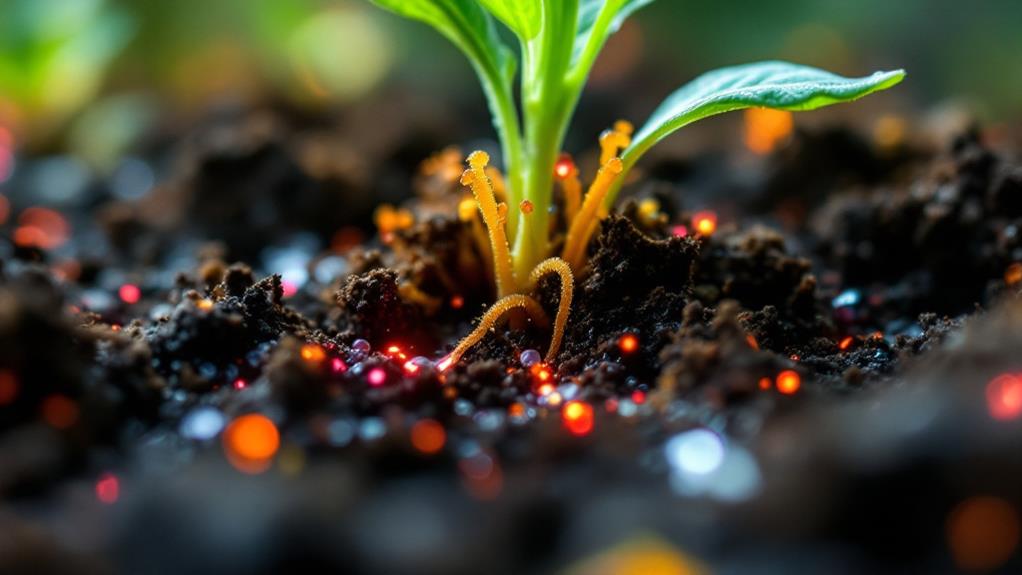
Delving into rhizodegradation reveals another fascinating aspect of phytoremediation. This technique harnesses the power of microorganisms living in the rhizosphere, the soil zone surrounding plant roots. In rhizodegradation, these microbes break down organic contaminants into simpler, less harmful substances.
You’ll find that plants play a vital role in this process. They release root exudates, which are organic compounds that stimulate microbial growth and activity. These exudates serve as food for the microorganisms, encouraging their proliferation and enhancing their ability to degrade pollutants.
The rhizosphere is a bustling ecosystem where bacteria, fungi, and other microorganisms thrive. As you explore this technique, you’ll discover that it’s particularly effective for treating organic contaminants like petroleum hydrocarbons, pesticides, and certain industrial chemicals.
To implement rhizodegradation, you’ll need to select plants with extensive root systems and those known to produce beneficial root exudates. Grasses, legumes, and certain trees are often used due to their fibrous roots and ability to support diverse microbial communities.
You’ll find that rhizodegradation offers several advantages. It’s a cost-effective, in-situ method that doesn’t require excavation or transport of contaminated soil. Additionally, it’s environmentally friendly and can improve soil structure and fertility.
However, you should be aware of its limitations. Rhizodegradation is typically slower than other remediation methods and may not be suitable for heavily contaminated sites or those with high concentrations of toxic pollutants that could harm the plants or microorganisms.
Hydraulic Control: Managing Contaminated Groundwater
While rhizodegradation focuses on soil contaminants, hydraulic control shifts our attention to managing polluted groundwater. This technique uses plants to influence the movement and distribution of groundwater, effectively creating a natural pump-and-treat system.
You’ll find that hydraulic control relies on trees with deep roots and high transpiration rates. These plants, often called “phreatophytes,” act as powerful pumps, drawing water from the ground and releasing it into the atmosphere. By strategically planting these trees, you can create a hydraulic barrier that prevents contaminated groundwater from spreading to clean areas.
When you’re implementing hydraulic control, you’ll need to take into account factors like soil type, depth to groundwater, and contaminant characteristics. You’ll also want to select plant species that are well-suited to your local climate and can withstand potential toxicity from the pollutants.
One of the main advantages you’ll notice with hydraulic control is its cost-effectiveness compared to traditional pump-and-treat systems. It’s also less disruptive to the environment and can be aesthetically pleasing. However, you should be aware that it’s a slower process and may not be suitable for all types of contaminants or in areas with very deep groundwater.
To maximize the effectiveness of hydraulic control, you’ll often combine it with other phytoremediation techniques. For example, you might use plants that not only pump water but also degrade or accumulate contaminants. This integrated approach can greatly enhance your overall remediation efforts, providing an extensive solution to groundwater pollution.
Phytoremediation in Urban Environments
In urban environments, phytoremediation faces unique challenges and opportunities. You’ll find that space constraints, soil compaction, and high levels of pollution can make implementing phytoremediation techniques more complex. However, the potential benefits for improving air quality, reducing urban heat islands, and restoring contaminated brownfields make it an attractive option for city planners and environmental scientists.
When you’re evaluating phytoremediation in urban areas, you’ll need to select plant species that are both effective at removing contaminants and adaptable to urban conditions. Trees like poplars and willows are often used due to their fast growth and deep root systems. You’ll also want to take into account native species that can thrive in your specific urban climate.
Urban phytoremediation projects often incorporate green infrastructure elements. You might see rain gardens, bioswales, and green roofs that not only remediate pollutants but also manage stormwater runoff. These systems can help reduce the burden on city drainage systems and improve overall water quality.
You’ll find that phytoremediation in cities can serve multiple purposes. Besides cleaning up pollutants, it can create green spaces for community recreation, improve biodiversity, and enhance urban aesthetics. However, you’ll need to address potential concerns about introducing plants in contaminated areas, such as the risk of contaminants entering the food chain through wildlife.
When implementing urban phytoremediation, you’ll need to work closely with local authorities, community groups, and environmental experts to guarantee the project’s success and safety. Long-term monitoring and maintenance plans are vital to track progress and adjust strategies as needed.

Erzsebet Frey (Eli Frey) is an ecologist and online entrepreneur with a Master of Science in Ecology from the University of Belgrade. Originally from Serbia, she has lived in Sri Lanka since 2017. Eli has worked internationally in countries like Oman, Brazil, Germany, and Sri Lanka. In 2018, she expanded into SEO and blogging, completing courses from UC Davis and Edinburgh. Eli has founded multiple websites focused on biology, ecology, environmental science, sustainable and simple living, and outdoor activities. She enjoys creating nature and simple living videos on YouTube and participates in speleology, diving, and hiking.

